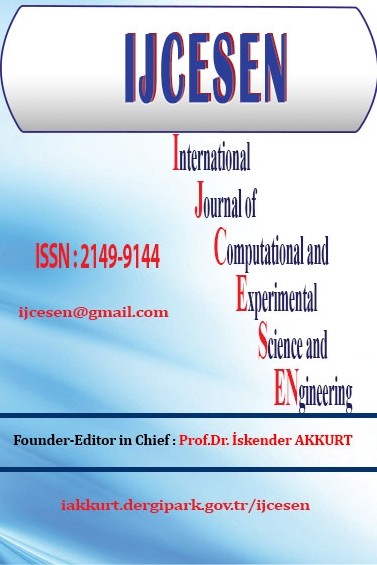An Investigation of the Formability, Mechanical Properties and Microstructure of Niobium and Niobium-Titanium Microalloyed Steels
An Investigation of the Formability, Mechanical Properties and Microstructure of Niobium and Niobium-Titanium Microalloyed Steels
Formability, Microalloys, Steel,
___
- [1] C. J. Van Tyne, D. K. Matlock, and J. G. Speer, “Microallyed Forging Steels” International Forging Congress, (2008) 189-197.
- [2] M. Hajisafari, S. Nategh, H. Yoozbashizadeh, A. Ekrami, “Improvement in Mechanical Properties of Microalloyed Steel 30MSV6 by a Precipitation Hardening Process” J. of Iron and Steel Research. (2013)66-73, DOI: 10.1016/S1006-706X(13)60100-4
- [3] Xiao-Huai Xue, Yi-Yin Shan, and Song-Nian Lou, “Microstructure Characteristic of Low Carbon Microalloyed Steels Produced by Thermo-Mechanical Controlled Process” Materials Science &Engineering A. 438-440 (2006) 285-287, DOI: 10.1016/j.msea.2006.02.064
- [4] M. Niikura, M. Fujioka, Y. Adachi, A. Matsukura, T. Yokota, Y. Shirota, and Y. Hagiwara, “New Concepts for Ultra Refinement of Grain Size in Super Metal Project” J. Mater. Process. Technol. 117 (2001) 341-346, DOI: 10.1016/S0924-0136(01)00800-7
- [5] E. Esenera , E. Sönmeza , M. Özsoyb and M. Firatb,∗ “Determining Springback Behavior of High-Strength Steels via Channel Forming Process” Acta Physica Polonica A. 132 (2017)1010-1012, DOI: 10.12693/APhysPolA.132.1010
- [6] V. Onar, S. Aslanlar and N. Akkaş, “Effect of Welding Current on Tensile–Peel Loading of Welding Joints in TRIP 800 and Micro-Alloyed Steels in Resistance Spot Welding” Acta Physica Polonica A 132(2017) 822-824, DOI: 10.12693/APhysPolA.132.822
- [7] H. Xie, L-X. Du, J. Hu and R.D.K. Misra, “Microstructure and mechanical properties of a novel 1000 MPa grade TMCP low carbon microalloyed steel with combination of high strength and excellent toughness” Mater. Sci. Eng. (2014) A612 123-130, DOI: 10.1016/j.msea.2014.06.033
- [8] E. Paul DeGarmo, J T. Black Ronald, A. Kohser, Materials and Process in Manufacturing, Ninth Edition, 2003 John Wiley & Sons, Inc.
- [9] European Committee for Standardization, “Metallic materials - Tensile testing - Part 1: Method of test at room temperature” (ISO 6892-1), 2016.
- [10] Danijela A. Skobir, “High-Strength Low-Alloy (HSLA) Steels” Materials and Technology. 45 (2011) 4 295-301.
- [11] H. Najafi, , R. Jafar, S. Asgari, “As-cast mechanical properties of vanadium/niobium microalloyed steels” Materials Science and Engineering. (2008) A 408 1-7, DOI: 10.1016/j.msea.2007.08.057
- [12] Hoda S. El-Faramawy, Saeed N. Ghali, Mamdouh M. Eissa, “Effect of Titanium Addition on Behavior of Medium Carbon Steel” Journal of Minerals and Materials Characterization and Engineering. (2012) 11 1108-1112, DOI: 10.4236/jmmce.2012.1111118
- [13] C. L. Davis, M. J. Balart, M. Strangwood, “Fracture Behaviour In Medium-Carbon Ti–V–N And V–N Microalloyed Ferritic-Pearlitic And Bainitic Forging Steels With Enhanced Machinability” Materials Science and Engineering A. 328 48-57, DOI: 10.1016/s0921-5093(01)01679-3
- Yayın Aralığı: 4
- Başlangıç: 2015
- Yayıncı: Prof.Dr. İskender Akkurt
Microstructure & Tribological Performance of Alumina-3wt% Titania Coatings Produced by APS
Mokhtar DJENDEL, Omar ALLAOUI, Mourad MAAZOUZ, Rabah BOUBAAYA
Boubaaya RABAH, Omar ALLAOUI, Mokhtar DJENDEL, Younes BENARIOUA, Zied DRISS
Analysis of Laser Pulse Heating Model Using the Finite Element Analysis
Erhuvwuvoke EBOJOH, John Ajokpaoghene AKPOBI, Kelechi NWOSU
The Determination of the Uniformity in Road Lighting Using Artificial Neural Networks
Mehmet KAYAKUŞ, İsmail Serkan ÜNCÜ
Shale Gas Technical Development and Innovation
Xingyuan LİANG, Ji HU, Qishuang ZHOU, Lei DU, Qiang Lİ, Baofeng Lİ, Yuan CHENG
Ali SANCAKTAR, Sebahattin KIRTAY, Aliye ARABACI
Study on Determination Method of Inter Well Pumping System for Liquid Supply Shortage Well
Xingyuan LİANG, Jiang LEİ, Yi LU
Thermodynamics of the Quark Gluon Plasma in the Early Universe
